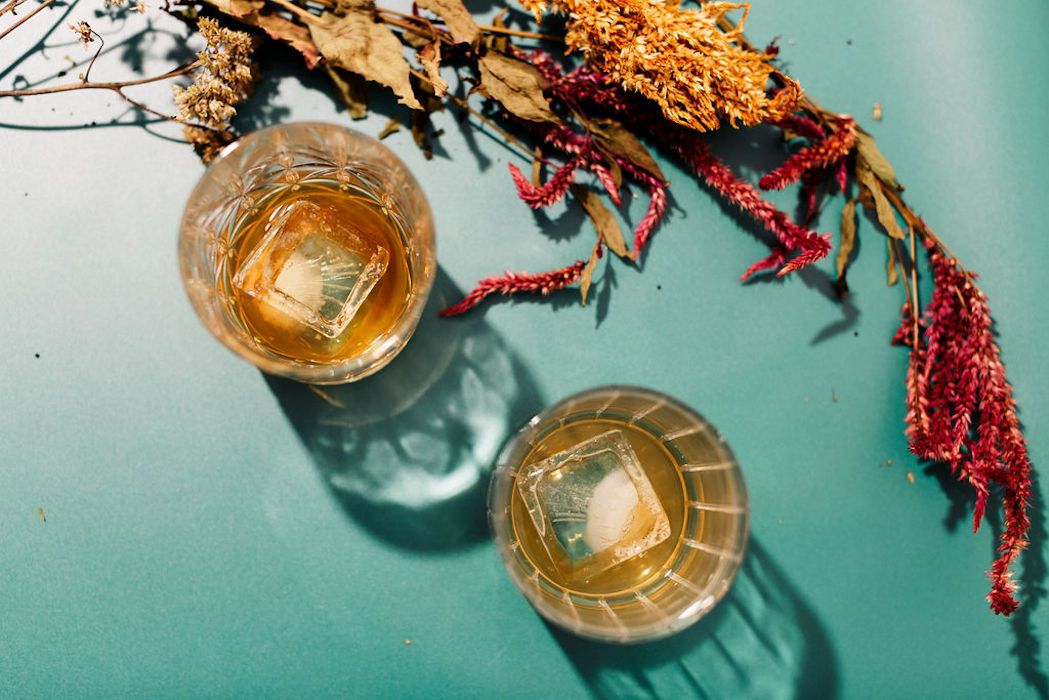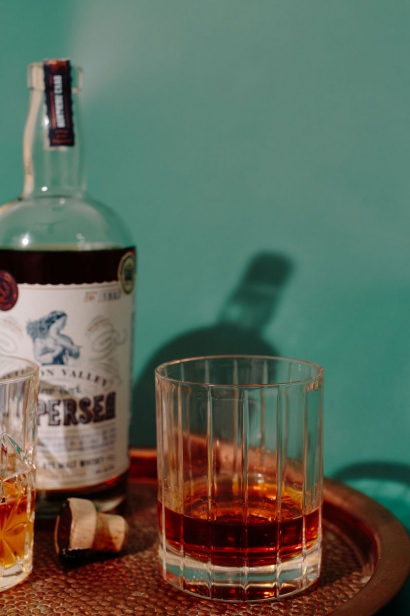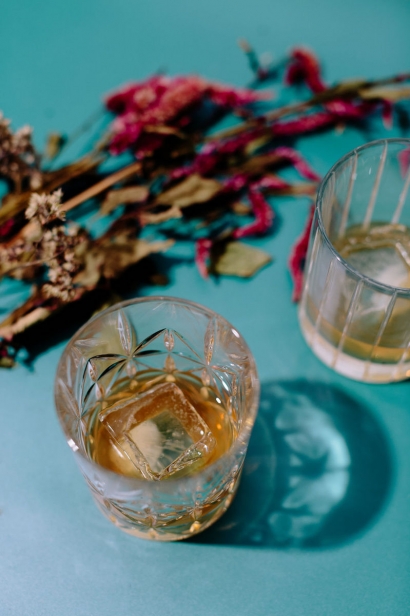New York Farmers and Distillers are Reinventing Whiskey
Scientists have discovered that drought is causing the Earth to literally wobble on its axis. Global politics and diplomacy have rarely (ever?) been as fraught with apocalyptic implications as they are now, causing the wee wobble to look like a childish distraction in comparison.
But let’s pan back for a second and head over to Rick Pedersen’s 1,500-acre vegetable farm and hop yard in Seneca Castle. Once you’ve arrived, it’s clear that physically and ideologically, it’s about as far from the world’s power center as one can journey without hopping on a rocket ship. (Cue a little rocket-man joke. Or actually, don’t).
At Pedersen Farms, amid the Romanesco, sweet corn and Fuggle hops, about 10% of the acreage is devoted to rye. In Pedersen’s fields, when the sun is out and the sky is blue, the rye looks ethereal. Emerald purses holding golden coins. It ripples and dances in a gentle breeze.
It looks delicate, even fragile, but don’t underestimate it. Rye is no weakling. According to Pedersen, it’s a hardy crop that grows better than wheat in cold and wet climates and can thrive in soils that would never support wheat. Pedersen knows soil; he has been tracking the relative merits of various crop-soil relationships since he was knee high to a grasshopper. As a boy, he managed to grow a cabbage nearly as big as he was (he still has the pictures and blue ribbons to prove it in his office). As a man, he’s using his field smarts to help grow one of the stars of New York’s answer to Kentucky bourbon (and Scotland’s Scotch, and Ireland’s whiskey): Empire Rye.
Empire Rye was officially conceived of in 2015 by a group of six New York State distilleries that decided to form a consortium dedicated to establishing a whiskey style for the region. They were in Denver at a craft spirits conference, and one thing led to another, as it often does, over glasses of tawny. Before their hangover wore off, they were on the phone, making arrangements and tweaks to their distilling and storage setups back home.
Pedersen Growing It
Thankfully, much of the groundwork was already laid. Pedersen, for example, got hooked into the Empire Rye project almost by accident and before it even had a name.
“Tom Potter came to me in 2009 because I am an organic grower with a reputation for trying new things,” Pedersen recalls. “He told me he wanted to make the kind of whiskey that hadn’t been produced here since Prohibition. Whiskey with a story. Whiskey that had real roots to the land, and flavor to match.”
When Potter, the co-founder of the Brooklyn Brewery in 1987 and then the New York Distilling Company in 2009, has an idea for a new drink he wants to develop, people tend to sit up and listen, and Pedersen says he was immediately game to try.
Besides, Pedersen, who launched the farm in 1986 with his fellow Cornell-grad wife, Laura, loves a good challenge, especially when it requires tinkering with weird seeds in the dirt.
“I called up the seed repository in Idaho and asked them for their oldest varieties in stock,” Pedersen remembers. University of Idaho’s Foundation Seed Program sent him about a dozen seeds from two strains that were indigenous to Eastern Europe and brought over in the 1700s. It was too late in the year to plant them himself, so he enlisted the Cornell University Agricultural Experiment Station to grow the first generation in their greenhouse. After two more generations, Cornell gave him three bushels to plant in the field. The seeds overwintered and matured in July. Pedersen could finally pass along the fruits of an acre-and-a-half in the ground to Potter in 2014. It was in storage for six months before he made a batch. It was clear from the start that one variety wouldn’t work, Pedersen says.
“But the Horton was a revelation,” Pedersen recalls. “After he made a pilot batch from it, he loved it because of the spicy, intense flavor.” The Horton variety fell out of favor because, like many other heirloom breeds, it had challenges that made it less practical for the farmer. Its yield is slightly lower, for example.
“It took me seven years to coax that handful of seeds into life, and then for Tom to get them in the bottle,” Pedersen points out. “Right now, I have 50 acres. I have to isolate the Horton fields so they don’t cross-pollinate with the other two rye varietals we have planted.”
The payoff, of course, is in the flavor. And between the time Pedersen planted those first seeds for a curious distiller, on a whim, and they appeared on the market, an entirely new category of whiskey was born.
Cornell Lays the Groundwork
Pedersen credits Cornell’s Agricultural Experiment Station with helping to coax his heirloom gems into fruition, but he says there’s actually a lot more to it than that. The Experiment Station has quietly been helping farmers (and winemakers, brewers and distillers) extract new layers of flavor from the soil since it was established by an act of the New York State Legislature on June 26, 1880.
To keep up with New York’s $4 billion agricultural machine, the Experiment Station has fueled up on grape, hop, bio-energy, organic pest and disease protection. More than 700 acres is devoted to test plots, orchards and vineyards, and more than 300 faculty, staff and students toil in greenhouses, fields and labs to bring consumers the latest and greatest in food and libations.
As David Benscher, a research and support specialist at Cornell’s School of Integrative Plant Science explains, the vision and purpose of the Experiment Station these days encompasses even more than economic enterprise. It involves making the dreams and visions of chefs like Dan Barber, winemakers like Carlo DeVito and spirits makers like Tom Potter, a reality. It’s also about figuring out how to nurture orphaned heirlooms bursting with flavor and history but abandoned for commercial shortcomings (not pretty, vulnerable to disease, bruise easily, etc.) again in New York soil. And making them—through selective breeding, and a lot of trial and error—hardy enough to sustain New York’s wild weather conditions without a lot of chemical intervention.
“There has been an explosion of interest in the past decade in heritage seeds,” Benscher acknowledges, adding that while it used to be produce farmers working with chefs who would approach Cornell for help, now grain farmers working with distillers, bakers and brewers were interested in tapping their wealth of expertise.
“The agricultural landscape has changed,” Benscher says. “In 2011, there were zero malt houses. Now there are around a dozen. When we started exploring different varieties of grains for beer and spirits, there were just 78 breweries. Now there are more than 400!”
Benscher works with a handful of farmers who are on the forefront of the specialty rye and malting barley movement, including Pederson, Ted and Patty Hawley of New York Craft Malt (they built the first malt house in 2012) and the folks behind a 1,255-acre experimental farm and regional incubator in Hurley (funded in part by Peter Buffett’s NoVo Foundation and run by the Kingston-based Local Economies Project).
Bottling the Magic
Christopher Briar Williams, chief distiller at Coppersea Distilling in New Paltz, was part of the original group at that whiskey-soaked Denver conference who fi rst put the notion of having a signature New York spirit on the table.
“A lot of the groundwork was already in place, we just didn’t have a name for it,” he explains. “There’s bourbon, there’s Scotch, there’s Irish whiskey. We all wanted a New York spirit that reflected the state’s history of spirits making pre-Prohibition. The obvious answer was rye whiskey.”
And not just any rye whiskey. The six originals (there are now several other official and pending members of the Empire Rye club) agreed to use primarily New York–grown rye. (For more on what makes a whiskey qualify as Empire, see below.)
“Every distiller has a different farmer or group of farmers they’re working with,” Williams explains, adding that he grows about 5% to 10% of the rye he uses himself on his 75-acre organic farm. “Even before Prohibition, a lot of grain farming had moved out to the Midwest, where the land is flatter.
That decision, while reasonable, had far-reaching consequences, Williams says.
“It eliminated the Northeast’s role as the breadbasket for the country,” he says matter-of-factly. “That role brought this region great prosperity and wealth, and when it went away, it was devastating for many farmers and communities.”
And along with cash and cachet, flavor also disappeared.
“Commodity crops sold as commodities can’t taste like a place, they can’t taste like anything distinctive, because aggregating them effectively destroys their provenance,” Williams argues. “But farmers in New York are rediscovering not only the flavor that can be found in some of these specialty grains but also the economic opportunity. Empire Rye is a niche, premium product. We pay prices that make it worth the farmer’s while to experiment and explore.”
Matt Jager of Yankee Distillers, concurs.
“We were actually meeting all of the criteria for Empire Rye before we even knew it was a thing,” he says. “We are all in for supporting New York farmers and bringing back the original style. We use six different farmers, and we really view ourselves as training wheels for them. We want to see the heirloom grain industry thrive in New York again, and the great thing about distilling is that any fungus or disease gets cooked off in the process, so they can learn from their mistakes but not lose their shirt in the process.”
In these apocalyptic times, over which we have little control, it’s perhaps more important than ever to invest in our communities and celebrate our histories. It’s especially delightful when that comes in the form of a spicy amber draught of 18th-century heirloom seeds, grown, distilled and bottled by neighbors.
Defining Terms
Rye: To merit an Empire Rye designation (look for the sticker on the label), at least 75% of the grain must be New York–grown rye; it must be distilled to 160 proof maximum; put in barrel at 115 proof maximum; aged for a minimum of two years in charred, new oak barrels.
Bourbon: The mixture of grains must be at least 51% corn, rye, wheat, malted barley or malted rye grain. In addition, it must be aged in charred oak barrels and cannot contain additives. (Examples: Wild Turkey, Jim Beam, Maker’s Mark, Woodford Reserve.)
Tennessee whiskey: The main difference between bourbon and Tennessee whiskey is the method of filtering. Tennessee Whiskey must be filtered via the Lincoln County Process, a method of filtering the mix through charcoal before it goes into casks. (Examples: Jack Daniel’s, Collier and McKeel.)
Irish whiskey: Made primarily from malted barley, Irish Whiskey goes through three rounds of distillation. To qualify as Irish whiskey, it must be aged for three years in Ireland in wooden casks. (Examples: Jameson, Midleton, Green Spot.)
Scotch Whisky: In addition to deleting the e, Scotch is whisky that has been distilled and matured in Scotland. It is made primarily from malted barley, peat, usually distilled twice and unlike bourbon, which is made from corn. (Examples: Glenlivet, Johnnie Walker, Macallan.)
The Founders & Early Adopters of Empire Rye
Black Button Distilling, a founder | @blackbuttondisitilling
85 Railroad Street, Rochester
Coppersea Distilling, a founder | @copperseadistilling
239 Springtown Road, New Paltz
Finger Lakes Distilling, a founder | @flxdistilling
4676 NYS Route 414, Burdett
Kings County Distilling, a founder.
299 Sands Street, Building 121, Brooklyn
New York Distilling, a founder | @nydistilling
79 Richardson Street, Brooklyn.
Tuthilltown Distilling, a founder | @tuthilltown
14 Grist Mill Lane, Gardiner
Van Brunt Stillhouse, an adopter | @thestillhouse
6 Bay Street, 1st Floor, Brooklyn
Yankee Distillers, an adopter | @yankeedistiller
5 Fairchild Square, Clifton Park
These distilleries have all committed to release Empire Rye in 2019:
Albany Distilling Co. | @albanydistillingco
Black Dirt Distilling Co. | @blackdirtdistillery
Upstate Distilling Co. | @upstatedistilling
Stoutridge Distillery | @stoutridge
Southern Tier Distilling Co. | @stdcspirits
Nahmias et Fils | @nahmiasetfils
Prohibition Distillery | @prohibitiondistillery
For more information and the latest news, check out empirerye.com
New York Craft Malt | @newyorkcraftmalt
NoVo Foundation
Local Economies Project
Pedersen Farms
Empire Rye | @empirerye
Brooklyn Brewery | @brooklynbrewery
University of Idaho’s Foundation Seed Program
Cornell University Agricultural Experiment Station
Cornell’s Department of Plant Breeding and Genetics
Dan Barber | @chefdanbarber
Carlo DeVito | @cddevito2








